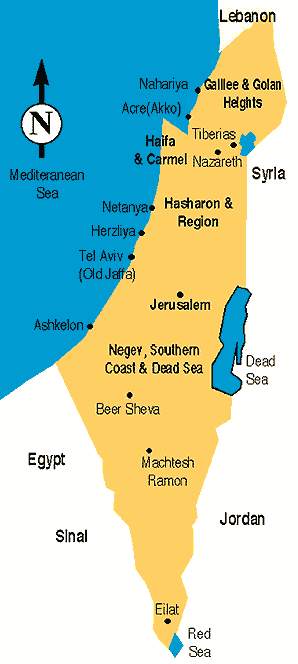
Israel is a land and a people. The history of the Jewish people, and of its roots in the Land of Israel, spans some 35 centuries. In this land, its cultural, national and religious identity was formed; here, its physical presence has been maintained unbroken throughout the centuries, even after the majority was forced into exile, With the establishment of the State of Israel in 1948, Jewish independence, lost 2,000 years earlier, was renewed.
Location
Israel is located in the Middle East, along the eastern coastline of the Mediterranean Sea, bordered by Lebanon, Syria, Jordan and Egypt. It lies at the junction of three continents: Europe, Asia and Africa
Geography
Long and narrow in shape, the country is about 290 miles (470 km.) in length and 85 miles (135 km.) in width at its widest point. Although small in size, Israel encompasses the varied topographical features of an entire continent, ranging from forested highlands and fertile green valleys to mountainous deserts and from the coastal plain to the semitropical Jordan Valley and the Dead Sea, the lowest point on earth. Approximately half of the country's land area is semi-arid.
Climate
Israel's climate is characterized by much sunshine, with a rainy season from November to April. Total annual precipitation ranges from 20-50 inches (50-125 cm.) in the north to less than an inch (2.5 cm.) in the far south. Regional climatic conditions vary considerably: hot, humid summers and mild, wet winters on the coastal plain; dry, warm summers and moderately cold winters, with rain and occasional light snow, in the hill regions; hot, dry summers and pleasant winters in the Jordan Valley; and semi-arid conditions, with warm to hot days and cool nights, in the south.
Flora and Fauna
The rich variety of Israel's plant and animal life reflects its geographical location as well as its varied topography and climate. Over 380 kinds of birds, some 150 mammal and reptile species, and nearly 3,000 plant types (150 of which are native to Israel) are found within its borders. About 150 nature reserves, encompassing nearly 400 square miles (almost 1,000 sq. km.) have been established throughout the country
Population
Israel is a country of immigrants. Since its inception in 1948, Israel's population has grown seven-fold. Its over six million inhabitants comprise a mosaic of people with varied ethnic backgrounds, lifestyles, religions, cultures and traditions. Today Jews comprise close to 79.2% of the country's population, while the country's non-Jewish citizens, mostly Arabs, number about 20.8%.
Main Cities
Jerusalem, Israel's capital (population 633,000), has stood at the center of the Jewish people's national and spiritual life since King David made it the capital of his kingdom some 3000 years ago. Today it is a flourishing, vibrant metropolis, the seat of the government and Israel's largest city.
Tel Aviv (population 348,000) which was founded in 1909 as the first Jewish city in modem times, is today the center of the country's industrial, commercial, financial and cultural life.
Haifa (population 265,000), a known coastal town since ancient times, is a major Mediterranean port and the industrial and commercial center of northern Israel.
Be'er Sheva (population 163,000), named in the Bible as an encampment of the patriarchs, is today the largest urban center in the south. It provides administrative, economic, health, education and cultural services for the entire southern region.
Israel is an old-new country, small in size, but with a widely varied landscape and a culturally active, heterogeneous population of some 5.9 million. It is a place where East meets West, where past and present touch, and where ideologies mold lifestyles. Four thousand years of Jewish heritage, more than a century of Zionism,, the 'ingathering of the exiles' and five decades of modern statehood have contributed to a culture which has already created an identity of its own, while preserving the uniqueness of 70 different communities. Emerging from the encounter between the individual and the society, it blends tradition and innovation, and strives to steer a course between Israeli particularism and universalism.
A largely immigrant and second-generation society, Israel's creative expression has absorbed many different cultural and social influences, as the traditions of each group not only vie with those of other groups, but also contend with the country's recent history and life in a Middle Eastern context. The constant search for cultural identity is expressed through creativity in a broad range of art forms, appreciated and enjoyed by a great many people as part of daily life.
Israel's international cultural ties focus on cooperation in a broad range of fields, including language, literature, the arts, science, media and sports. Based on cultural agreements with more than 70 countries, in addition to links with many others, activities range from student and academic exchange programs and reciprocal tours by dance troupes, theater companies, art exhibits, musicians and orchestras, to participation in book fairs, film festivals and sports competitions as well as the teaching of the language and cultural traditions of both countries.
ARIEL is Israel's leading cultural magazine. It has been published since 1962 and gives extensive coverage to all fields of the arts and literature in Israel - prose and poetry, cinema, dance, apinting and sculpture, music, archaeology, architecture and literary criticism. Its contributors include Israel's leading men and women of letters and the arts and academic figures.
Ariel is published quarterly in English, French, German, Spanish, Arabic and Russian editions. Readers who wish to keep abreast of Israel's cultural scene will find it an invaluable source of information. Interested subscribers should apply to Israel's diplomatic missions abroad.